Education
About Andrew Cusack
 Writer, web designer, etc.; born in New York; educated in Argentina, Scotland, and South Africa; now based in London.
Writer, web designer, etc.; born in New York; educated in Argentina, Scotland, and South Africa; now based in London. read more
News
Blogs
Reviews & Periodicals
Arts & Design
World
France
Mitteleuropa
Knickerbockers
Argentina
The Levant
Africa
Cape of Good Hope
Netherlands
Scandinavia
Québec
India
Muscovy
Germany
Academica
Letter to the Editor
A letter to the editor printed in this week’s edition of The Tablet:
Brendan Walsh’s report (“Heythrop’s fate”, 17 September) of a senior academic suggesting that the demise of Heythrop was an episode in a long struggle between “outward-facing, inquisitive, challenging” theology on one side and “inward-looking, submissive, unquestioning” theology on the other is telling.
Positing such a simplistic binary split between Enlightened Me and Poor Ignorant You is patronising to those attempting to live out the radical beauty of the Christian life in tune with Catholic teaching. It’s not surprising that an institution with academics holding this view is entering its death spiral, while religious communities that don’t consider basic orthodox belief as optional are bursting at the seams.
Few things are more challenging – and more rewarding – than faithfulness; while some cling to clapped-out heterodoxies and managed decline, the rest of the Catholic world has moved on.
ANDREW CUSACK
London SW1
University Nicknames in South Africa
In the course of reading any South African newspaper article about universities, the unacquainted reader may be confused by some of the terminology involved. “Maties Slaughter Ikeys” is a common enough headline prototype — given that, I think, the last time the Ikeys (University of Cape Town) beat Maties (Stellenbosch) in rugby, a white man was president.
What are these mystical nicknames for South Africa’s universities, clouded in mystery to the outsider? Here is a handy guide. (more…)
Ireland needs an undeniably world-class university
NOT A SINGLE Irish university made it into the top 100 of the Times Higher Education World University Rankings this year, but reviving an old proposal might give Ireland more global clout in the academic sphere. While all rankings systems are on some level arbitrary, the THE takes into account the views of over 17,000 academics across the planet and gives us an insight into how institutions — and by extension their host countries — are perceived not only in academia but also in the perhaps more lucrative field of research and development.
Being pushed out of the top 100 doesn’t necessarily indicate that higher education in Ireland is in any crisis; it could merely reflect the comparative rise of other institutions in countries which are beginning to appreciate the value of academic research and institutional prestige. But a country shouldn’t rest on its laurels, and it’s worth asking: Is Ireland missing an opportunity to have a university of unquestionable world-class status?
Reflecting on the 2012 THE rankings, political commentator Richard Waghorne suggested via Twitter that it is high time that University College Dublin, Trinity, and Dublin City University were amalgamated into the University of Dublin. This is an idea with a long heritage which, even if it is to be rejected, needs to be considered seriously. (more…)
Best Universities in the World
From north to south, a completely arbitrary and biased accounting
WHILE UNIVERSITY rankings within countries have been popular for some time now, especially in the United States and United Kingdom, it’s only been in the past decade or so that worldwide rankings of universities have come to the fore. The most widely known is probably the Academic Ranking of World Universities produced by Shanghai Jiaotong University, alongside the QS World University Rankings from the firm Quacquarelli Symonds, and the T.H.E. World University Rankings from the weekly magazine Times Higher Education. All such ratings employ varying statistical matrices and methods of divination obscure to the outsider but which, one supposes, must have some form of merit. They are more useful for gaining a general impression of the place of a university rather than comparing and contrasting two or more particular institutions.
The aforementioned ranking structures are rather to formal for us to gain all that much knowledge from. Personal interactions, reputation, age, style of architecture, and other such factors carry much greater import when I judge universities. Oxford and Cambridge, whether you like it or not, are still the top universities in the world, even if they might not be our favourites. You just can’t beat them. While they might not be as much fun as other places, they come closest to achieving the balance of age, tradition, interesting people, serious research, good location, and general niftiness.
For a certain type of person, Harvard remains paramount among American universities, but to be a Harvard undergrad has carried a certain social stigma in our quarters for the past two or three decades. Harvard Business School, however, remains perfectly acceptable. In the Ivy League, Yale, not Harvard, is king, followed by Brown (not thanks to its radical professoriate but rather due to the strong Continental infiltration amongst its studentry). Dartmouth is the fun #3 of the Ivies, while the rest are forgettable (well, Princeton’s not bad really — it has the Whitherspoon Institute — but Cornell, Columbia, and Penn are yawn-worthy).
Up to this point, we have been speaking generally, but there are topical institutions of course. If you really must study ‘business’, then there’s Harvard Business School or INSEAD. Are there any other business schools of actual note? In the military realm, Sandhurst is the unquestionable king. The École royale militaire in Brussels is up there — being Catholic, Francophone, and monarchic attracts good elements from outside Belgium. In the States, there is the Citadel and VMI, but not much else (the federal ‘service academies’ have poor reputations except for Annapolis). One doesn’t hear much about Saint-Cyr these days.
Speaking of France, the reason one can’t come up with proper rankings is because some institutions or groups of institutions would be entirely outside it. The grandes écoles are the best example. They are superbly elitist, the absolute top, but they mostly exist in that little French world, with all its delights and limitations.
But for ‘topical’ institutions, the University of London has plenty: SOAS, LSE, the Cortauld, the various institutes of the School of Advanced Study, etc., etc.
There are also those interesting little schools of art history and conservation, attached to museums like the V&A or auction houses like Sotheby’s and Christie’s. The École du Louvre, however, must be the queen regnant of these schools.
Charles Taylor’s presence at McGill alone makes it worthy of note, but one suspects there are other strengths at the university. At any rate, it is still a perfectly respectable place to be an undergraduate. Boston College is also quite strong at the postgrad level, except in the theology school where heresy is widely believed to be thriving. Given the wealth and particularity of America’s universities, there are small and unknown centres of excellence in many unexpected places (for example the quite strong literary translation centre at the University of Rochester).
Rome’s universities of both church and state have shabby academic reputations but still attract for being Roman. One always hears seminarians complaining about the Gregorian, but no one can never really complain about Rome, and being a student or a seminarian is as good a reason to be in Rome as any. Rome also has John Cabot University, an ‘American’ institution divided between Americans on their semester abroad and the full-timers (often the layabout members of larger European families, who also frequent the American University of Paris).
And of course many of the Italian universities are not so much places of learning as conspiracies for the avoidance of unemployment on the part of their academics and administrators. Regrettably, much Italian talent moves abroad for higher salaries and better working conditions (Cavalli-Sforza, to name but one, at Stanford), but the handful of scuoli superiori (e.g. the Scuola Normale in Pisa) still maintain their dignity.
In Spain, Salamanca is well-regarded, and there are a number of newer, private, properly Catholic entities that have been created. Of course, Opus Dei are very proud for having created the University of Navarre ex nihilo. Portugal, meanwhile, has yet to recover from the Marques de Pombal’s disastrous eighteenth-century reform of Coimbra.
If you’re one of those people who actually wants a proper education then, for better or worse, you must go to America. Thomas Aquinas College in California and St. John’s College in Maryland might be the last genuine places of higher learning in the European world. Attempts are being made to found a British Catholic version, and many imitations (Catholic, Protestant, and secular) exist around the United States.
If I could name some other honorable mentions in addition to those featured below, I would add Dublin (Trinity, that is), Bristol, the Collège d’Europe, Leiden, Leuven, Utrecht, Uppsala (and all the old Scandos), Heidelberg (and a dozen other German universities), King’s Halifax, Trinity College in Toronto, some parts of Berkeley, York for graduate study but not undergrad, the C.E.U. in Budapest (despite being a Soros project), and Exeter and Warwick aren’t bad really. Some universities, like the Jagiellonian in Kraków or the Charles in Prague, must be mentioned due to age, but I have to plead ignorance as to any knowledge of their current state.
I’m probably leaving out a dozen places that deserve a mention but I’ve forgotten; such are the limits of our fallen human nature. Here follows, arranged from northernmost to southernmost, our completely arbitrary and biased accounting of the six best universities in the world. (more…)
Decline of the Herr Professor
The Herr professor has been caught up in a whirlwind of protest, eventually to emerge as a humble guest on a television talk show.
No Nobel prize compensates for this loss of prestige at the apex of a crumbling pyramid.
His desperate references to the false problem of “academic freedom” sound not only hollow, but like the exchanges between pagan Roman priests at magical ceremonies in whose effectiveness they no longer believed.
Modern Age, Spring 1999
St Andrews, William & Mary join forces
The oldest universities in Scotland and Virginia announce they will offer a series of joint degree programs
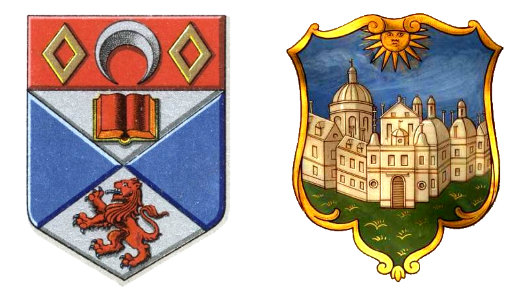
The University of St Andrews in Scotland and the College of William & Mary in Virginia are to begin offering joint degree programs starting in the autumn of 2011. Students admitted to the programs will receive a single Bachelor of Arts degree issued on behalf of both institutions — which will be the only B.A. offered by St Andrews, whose arts & humanities undergraduates typically graduate with an M.A.
The joint degrees will be available in four fields — history, international relations, English, and economics — with the aim of combining the depth traditional to the Scottish style of education with the breadth of William & Mary’s liberal curriculum. Students will spend the first year at their home university, followed by a second year abroad, with the remaining two years divided between the two. The program will start with about forty students divided between the two, with the hope to gradually double that size.
St Andrews is the oldest university in Scotland, and third-oldest in the English-speaking world. The College of William & Mary (now a university, despite its name) is the oldest in Virginia, the second-oldest in the United States, the third-oldest in North America, and the ninth-oldest in the English-speaking world. William & Mary, which is located in Virginia’s ancient capital of Williamsburg, has traditionally maintained links to Great Britain even after the Dominion of Virginia was recognised as independent in 1783. Queen Elizabeth II has visited the College twice, first in 1957 and more recently in 2007, and her former prime minister, Baroness Thatcher, served as Chancellor of the University.
Outside Germany, Press Lack Interest in Odenwaldschule Abuse Scandal

Nestled in rustic style buildings amidst the hills of the Odenwald mountains, Germany’s most prominent progressive boarding school has become embroiled in the latest revelation of abuse in German schools. Almost the entire governing board of the Odenwaldschule has resigned after it was revealed that a culture of permissive abuse of schoolchildren was tolerated from 1966 to 1991, involving at least thirty-three victims and eight teachers, and perhaps more. The details of the case are too lurid for reproduction here, but involve the abuse of students by teachers and even a headmaster, as well as tolerating and sometimes encouraging the abuse of students by other students.
The Odenwaldschule was founded in 1910 by Paul and Edith Geheeb as one of the first schools devoted to “progressive education” in Germany. Amongst other novelties of the school, students were divided into “families” that spanned age groups and were headed by a teacher known as the “mother” or “father” of the “family”. Shut down during the Nazi period, it reopened after the war, and became a UNESCO model school in the 1960s. Among its former students is the Green MEP & former student radical Daniel Cohn-Bendit, who admitted in the 1970s to inappropriate contact with kindergarten students before backtracking after his previous comments were brought to light last year. The school’s progressive “holistic” ethos, emphasizing freedom over discipline, continues to this day. For the current 225 students, the cost of a year’s education at the Odenwaldschule is over $27,000, or £17,000.
The revelations are only the latest among many surrounding Catholic, Protestant, secular schools, as well as the schools of Communist East Germany. Outside Germany, however, the mainstream media have only taken an interest in whichever scandals or stories they can link back to Pope Benedict XVI, or, failing that, his brother Fr. Georg Ratzinger. No English-language media from outside Germany have bothered to report on the Odenwaldschule affair, except for the tiniest of mentions in the Guardian on 17 March.
Universitas Catholica Ucrainorum, Leopolis
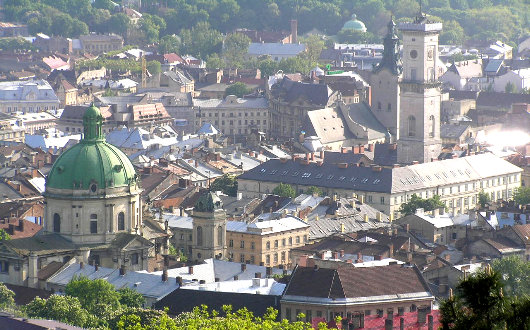
Lviv — sometimes called Lemberg, Lwów, or Leopolis — sits in one of those corners of Europe that has born tremendous witness to the unfolding of history over the centuries. It was founded in the fourth century, built by the Poles, besieged by the Turks, ceded to the Austrians, regained by the Poles, captured by the Nazis, subjugated by the Soviets, and finally freed under an independent Ukraine. Lviv is the capital of Carpathia… and Galicia… not to mention Ruthenia, and nobody can quite define the difference between those three places, while some even argue that one or another (or all) don’t actually exist. For now, we can say with authority that Lviv is the most prominent city in the western Ukraine, and has for centuries been an important place of Catholic culture.
As Damian Thompson points out, Lviv is now home to the Ukrainian Catholic University (Український Католицький Університет). “You must look into this place,” Edward Lucas of the Economist told Damian Thompson: “It’s quite amazing.” (more…)
The Royal Military College of St. John

WHAT BETTER WAY to celebrate this, the feast of St. John the Baptist and the national day of Quebec, than to bring you news of the reëstablishment of the Collège militaire royal de Saint-Jean. The site in the town of Saint-Jean-sur-Richelieu was first put to a military use in 1666 when the French soldiers of the Carignan-Salières Regiment. The Collège militaire royal, however, was only founded in 1952 when it was inaugurated by the Rt. Hon. Vincent Massey, CC, CH, GCStJ, CD, PC as a classical college to increase the number of French-speaking officers in the Army, the Royal Canadian Navy, and the Royal Canadian Air Force.
And you thought subsidising the poor was bad…
Millions of tax dollars taken from hard-working Americans are going to subsidise one of the wealthiest school districts in the country
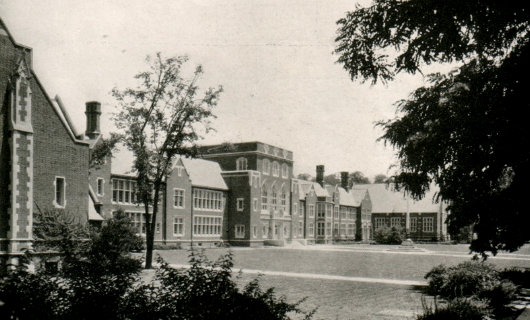
The Bronxville School (as it is called, since all grades from kindergarten to 12th are in the same building) ostensibly has a number of things going for it. It has a rather splendid collegiate gothic building in an excellent setting in one of the handsomest villages in all of the Empire State. Its school district is a mere square-mile, meaning most students can walk to school and it doesn’t even have a bus system. It has a private foundation funded independently by parents and alumni to support the school. What more could a public school possibly need?
Well, according to the geniuses down in Washington, D.C., $5.4 million in federal grants. The school, you see, is built on a site which frequently floods. Our main street in Bronxville is called Pondfield Road for a reason: the field with the pond is the open space where the school now stands. It’s been flooding for decades and so floods should come as no surprise. The nor’easter that blew through town a year ago flooded the school severely, closing it for over a week. The flooding was particularly bad during the last nor’easter because the school had spent a great deal of money (privately-raised, not from the public purse) to replace its natural football field with a lower-maintenance fake turf alternative. They did this instead of saving the money for, oh, say, one of those floods that happens every so often.
The money has been secured from the Federal Emergency Management Agency by our congresswoman, Nita Lowey (D). “When a natural disaster occurs, the federal government has a responsibility to help communities recover,” said Lowey, who neglected to provide any legal or moral backing for such an untruthful and baseless claim.
The school district of one of the wealthiest communities in the country is filching off the hard-working people of America in order to clean up the mess that is a direct result of its own poor spending decisions and inability to plan properly. Is there no shame?
Salve Regina

ONE OF THE MORE unfortunate aspects of the twentieth century was the decline of the country house in the British Isles and North America during the post-war period. Innumerable homes of great history and beauty were lost to the wrecking ball and the developer’s avarice. Newport, the former capital of the Colony of Rhode Island and Providence Plantations, became a summer capital to many of America’s well-to-do during the so-called “gilded era”. (It was avowed then that the highest level of society was determined by those whom Mrs. Vanderbilt could fit in the great hall of her Newport house). While many of the great homes of Long Island fell to ruin after the war, and the legendary Meadowbrook Hunt dissolved, many of the best Newport homes found a welcome new role under the wings of Salve Regina University, the city’s Catholic university. The decline of these great houses and the ascent of Salve Regina proved a quite fortunate coincidence, and has inspired the university to start one of the first academic programs in historical preservation and restoration. These great summer ‘cottages’ now house lecture halls, seminar rooms, academic offices, dormitory space, and a Catholic chapel. They are appropriate surroundings for Western civilization to be passed on to the next generations. (more…)
‘OUCA flag pilfered by splinter group’
Cherwell, 26 May 2006
THE FLAG of the Oxford University Conservative Association has been stolen by a splinter group and is being held at ransom. David Cochrane and Ian Wellby raised the flag up the Keble flag pole in an act that Cochrane says “claimed Keble for OUCA”.
“This does mark an historic occasion for OUCA as we have essentially created a new OUCA. We have got rid of all the gimps and all is fun now,” he said.
“This is a historical occasion comparable to Labour’s landslide in 1997, the end of the Hundreds Year War, the first time that William Shakespeare put pen to paper, the development of penicillin, or the winning of World War II,” he added.
By the next morning the flag had been taken down by the porters and had been claimed by a group calling themselves the People’s Front for the Liberation of OUCA, and who are believed to be loosely associated with the Moles Dining Club.
The Spiritual Leader of the People’s Front for the Liberation of OUCA said, “The OUCA colours have been liberated from under the very nose of the criminal Steel. They have been taken ‘Over The Water’. They shall remain there until True Monarchy is restored to OUCA. The nefarious Steel must be deposed and face justice for his manifold crimes.”
An ex-OUCA member who was present when the flag was stolen said that the oversized flag was a tradition, and that their actions were a response to rumours that Charlie Steele, the current OUCA President, planned to sell the flag.
Steel said, “Although it is no bad thing to see the OUCA flag grace the mast of the Keble flag pole, and indeed this is essentially harmless fun, it is very disappointing that people have taken it upon themselves to then steal it the following day. This amounts to nothing more than theft, and the Association will not tolerate illegal behavior of any kind.”
The Dean of OUCA, Reverend David Johnson, said, “It was incredibly stylish to fly the flag from Keble. It was bought at an extortionate cost of £400, and I thought it was ludicrous, but when it was draped over a table I thought it looked rather smart and was sort of nostalgic.”
Dartmouth Craziness
The New Criterion‘s Stefan Beck (black iced coffee, no sugar) has an excellent little ditty in National Review on a little brouhaha up in Hanover, New Hampshire. It makes me somewhat glad that I go to a university where religion is generally met with the rolling of the eyes or a quick nap rather than modernist ire and indignation.
Back in the Day
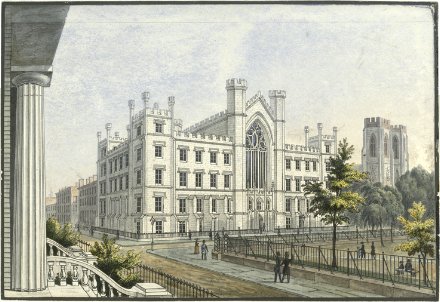
The University of the City of New York (now New York University),
Washington Square, 1850.
Public Elitism
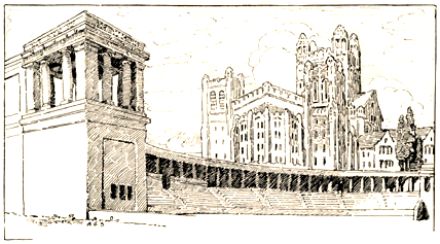
The Manhattan Institute‘s splendid City Journal of Spring 1999 carried an article worth a read entitled ‘How Gotham’s Elite High Schools Escaped the Leveller’s Ax’ on the few quality public schools left in the City of New York and how they managed to stem the tide of egalitarian senselessness.
Egalitarianism is one of the most morally repugnant of all ‘Englightenment’ ideas. To look upon success, label it “unfair” or “racist”, and then demand that, as a sacrifice to the false-goddess Equality, all must fail. It is the typical socialist formula that it is better that all wallow in poverty rather than only some (or even many but not all) succeed.
So a number of these high schools have survived. It is perhaps even more of a shame that none of the colleges did. City College was once known as “the poor man’s Columbia”. The quality of education at both City College and Columbia fell as a result of the cultural revolution of the 1960’s and 70’s. Columbia, for the most part free from the fetters of state intervention, never hit rock bottom and in many ways remains a quality institution, despite the highly politicized and racialized nature of many of its students and faculty. City College, however, went into freefall. Admission was thrust open to anyone who had graduated from a New York public high school, which coincided with the lowering of graduation requirements by these high schools. Thus you had students who could barely read and almost certainly could not write attending an institution which prided itself on its many Nobel laureates.
It is testament to the levelling zeal of the angry left that not even one college, not even one, within the entire City University of New York was allowed to maintain high standards of academic achievement. They will tear down with savage avarice the highest ideals of civilization to quench their destructive thirst. And these are colleges which for decades had been the ticket to freedom and success for hundreds and thousands of economically-disadvantaged New Yorkers. (Imagine if they had gotten their hands on the independent places of learning!). No wonder there are so many stupid people in New York these days.
But at least the high schools are still there, and calls for their emasculation are now few and far between. True, they are not ideal, but can we realistically expect a government-tethered school to be as such? Of course not. We should be glad that there remain at least a handful of public academies of high standards in New York available to all – rich, poor, and anywhere in between – based purely on merit.
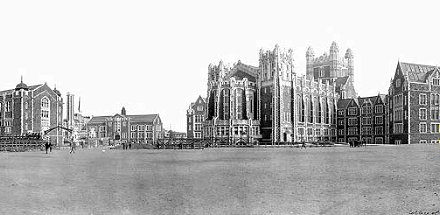
T.R. on Education
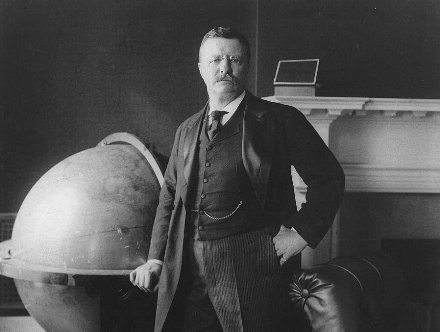
Oxford? Cambridge?
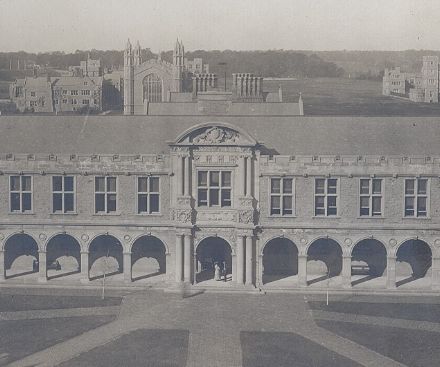
Missouri. A view of the quadrangle of Washington University in St. Louis, to be more precise. If you ask me, they should’ve implemented the 1925 plan to further develop the campus.
The Colonial Colleges
| NAME |
LOCATION | FOND. | CHART. | DENOM. |
| Harvard College (Harvard University) |
Province of Massachusetts Bay |
1636 | 1650 | Puritan |
| College of William and Mary |
Colony and Dominion of Virginia |
1693 | 1693 | Anglican |
| King William’s School (St. John’s College) |
Province of Maryland |
1696 | 1784 | Non-denominational |
| Yale College (Yale University) |
Connecticut Colony |
1701 | 1701 | Congregationalist |
| Moravian College |
Province of Pennsylvania |
1742 | 1863 | Moravian |
| Newark Academy (Univ. of Delaware) |
Delaware Colony |
1743 | 1833 | Non-sectarian |
| College of New Jersey (Princeton University) |
Province of New Jersey | 1746 | 1746 | Presbyterian |
| Augusta Academy (Washington and Lee University) |
Colony and Dominion of Virginia |
1749 | 1782 | Non-sectarian |
| Public Academy of Philadelphia (Univ. of Pennsylvania) |
Province of Pennsylvania |
1749 | 1755 | Non-sectarian |
| King’s College (See below) |
Province of New York | 1754 | 1754 | Anglican |
| Rhode Island College (Brown University) |
Colony of Rhode Island and Providence Plantations |
1764 | 1764 | Baptist |
| Queen’s College (Rutgers University) |
Province of New Jersey | 1766 | 1766 | Dutch Reformed |
| Dartmouth College | Province of New Hampshire | 1769 | 1769 | Congregationalist |
| College of Charleston | Province of South Carolina | 1770 | 1785 | Non-sectarian |
| Salem College | Province of North Carolina | 1772 | 1866 | Moravian |
| Hampden-Sydney College | Colony and Dominion of Virginia | 1775 | 1783 | Presb. |
Note One: “Non-denom.” should be interpreted as Christian but not of a denominational nature. “Non-sectarian” should be interpreted as secular and having little or nothing to do with religion.
Note Two: King’s College in New York has two successor institutions: King’s College in Halifax, Nova Scotia, and Columbia University in New York, New York. The largest portion of the faculty of King’s College in New York fled north and in 1789 refounded the college in Windsor, Nova Scotia. However, the original buildings of King’s College were usurped by a new institution called Columbia College four years earlier in 1784.
King’s College formerly counted its foundation from 1754, while Columbia used the 1784 date. However, this has since switched and Columbia now proudly (though perhaps dubiously) claims 1754 as its foundation while King’s College more safely uses 1789.
Perhaps both institutions have a shared right to the founding date, as the loyal alumni continued their allegiance to King’s in Nova Scotia while the rebellious graduates considered Columbia the rightful heir. As stated, Nova Scotia had more of the people from the original foundation, whereas New York had little more than the physical building and a few of the graduates. I would be inclined to award 1754 to King’s College and 1784 to Columbia, (but then I’m biased against Columbia for being such a fallen institution).
Canon Bernard Iddings Bell
Warden of St. Stephen’s College in the Hudson Valley of New York
As for what the Church thinks and says, what influence does that have on the handling of American politics, the conduct of American education, the regulation of marriage and divorce, on sex and drink, on how industrial disputes are settled, on how we carry on business?
As a plain matter of fact, religion in this country is generally regarded as a tolerated pastime for such people as happen to like to indulge in occasional godly exercises — as a strictly private matter in an increasingly close-knit and socially acting society — in other words, as something that does not count.
I should like to see the Church recognize that it has been pushed into the realm of the non-essentials, and to persuade it to fight like fury for the right and the duty to bring every act of America and Americans before the bar of God’s judgment.
[Christian leaders] are making valiant claim to such a right and duty; but the great mass of Church members are content to regard the Church as a conglomerate of private culture clubs, nice for christenings, weddings and funerals. Most Church members readily agree with the unchurched majority that it is not the proper business of the Church to criticize America or Americans.
— Canon Bernard Iddings Bell
The 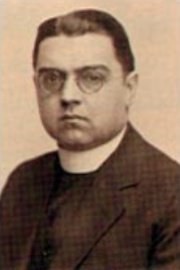 Rev. Canon Bernard Iddings Bell and seems to have been something all too rare in the history of America: a wise and presient Episcopalian cleric (which is not to say we have had any more than a mere handful of wise and presient Catholic clerics in this land).
Rev. Canon Bernard Iddings Bell and seems to have been something all too rare in the history of America: a wise and presient Episcopalian cleric (which is not to say we have had any more than a mere handful of wise and presient Catholic clerics in this land).
Bell served as Warden of St. Stephen’s College – situated on the Hudson River here in New York – from 1919 to 1933, and is widely considered responsible for turning it into what was one of the best collegiate institutions in the country. In 1928, under Bell’s tenure, St. Stephen’s became a college of Columbia University, and this period of the College’s history was highly praised by the great Russell Kirk.
Kirk, in Decadence and Renewal in the Higher Learning, after positing his view of the ideal undergraduate college as a place of classical and liberal learning, takes note of St. Stephen’s. “There have been such colleges in this country,” Kirk wrote. “One such was St. Stephen’s College… when Dr. Bernard Iddings Bell was president. (He told me once that he gave up the presidency when strong objection was raised to his rule that the students should dress decently and rise when professors entered a room.)”
Of course, such arcadian days did not last. Only a year after Bell gave up the wardenship of St. Stephen’s in 1933, the college changed its name from honoring Saint Stephen, the first Christian martyr, to the more secular Bard College honoring the founder of the institution, John Bard.
A mere ten years later in 1944, Bard College became coeducational and as such severed its relationship with Columbia University, becoming independent as a secular, nonsectarian liberal arts college ‘affiliated’ with the Episcopal Church. The once-great college has now declined to such an extent that a professorship there is now named in honor of Alger Hiss, the man who betrayed America to spy for Soviet Russia. Sic transit gloria mundi.
Kirk relates another anecdote of Dr. Bell:
Canon Bernard Iddings Bell once showed a visitor from England about the environs of Chicago. They drove past a handsome Gothic building of stone. “Is that a school?” inquired the visitor.
“Yes– a new one, ‘distressed’ to appear old,” Dr. Bell replied.
“Indeed! Who is the headmaster?”
“There is no headmaster.”
“Curious! A kind of soviet of teachers, I suppose.”
“There are no masters at all.”
“Really? Do the boys teach one another?”
“As yet, there are no students. Here in the United States, we proceed educationally in a way to which you are unaccustomed,” Canon Bell told his friend. “First we erect a building; then we obtain pupils; next we recruit teachers’ then we find a headmaster; and at last we determine what is to be taught. You begin at the other end in England.”
Again, a quote from Canon Bell:
We need to forget the imaginary Christ who has been ours too long and to rediscover the real Christ, the Christ of the prophets and the martyrs and the confessors, the Christ who is not only the lover of souls but also master, a monarch with demands to make in industry, in finance, in education, in the arts, in marriage, in the home; the Christ who is teacher of a social ideology which has eternal validity; the Christ who cries aloud with convincing force, ‘He who would save his life will lose it; only he who is willing to lose his life, can find it.’
Search
Instagram: @andcusack
Click here for my Instagram photos.Most Recent Posts
- Teutonic Takeover March 10, 2025
- Katalin Bánffy-Jelen, R.I.P. March 3, 2025
- Substack Cusackiensis March 3, 2025
- In the Courts of the Lord February 13, 2025
- American Exuberant February 10, 2025
Most Recent Comments
Book Wishlist
Monthly Archives
Categories


